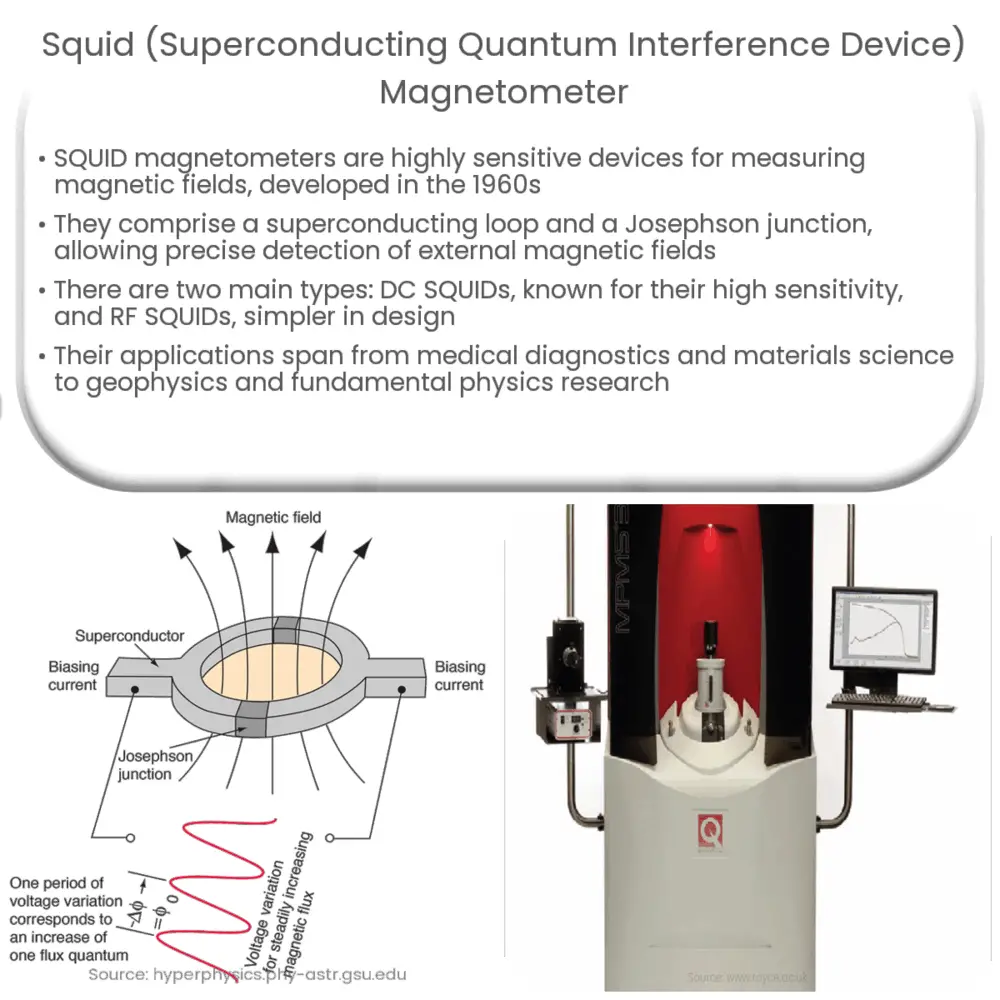SQUID magnetometers are highly sensitive devices for measuring magnetic fields, with applications in medicine, physics, and geophysics.

SQUID Magnetometer: The Superconducting Quantum Interference Device
Introduction to SQUID Magnetometers
SQUID magnetometers, or Superconducting Quantum Interference Devices, are among the most sensitive devices available for measuring magnetic fields. Developed in the 1960s, SQUIDs have become an essential tool in various fields, including physics, geophysics, material science, and medicine. This article provides an overview of the principles behind SQUID magnetometers and their diverse applications.
How a SQUID Magnetometer Works
A SQUID magnetometer consists of two main components: a superconducting loop and a Josephson junction. The superconducting loop is made of a superconducting material, which has zero electrical resistance when cooled to extremely low temperatures. This property allows the loop to sustain a persistent electric current without losing energy.
The Josephson junction, on the other hand, is a thin insulating barrier between two superconductors. It allows electrons to tunnel through via the quantum mechanical process known as Josephson tunneling. This phenomenon creates a relationship between the voltage across the junction and the phase difference of the superconducting wave function between the two superconductors.
When an external magnetic field is applied to the superconducting loop, it generates a change in the magnetic flux threading the loop. According to Faraday’s law of electromagnetic induction, this change in flux induces an electromotive force in the loop, which in turn alters the phase difference across the Josephson junction. By measuring the voltage across the junction, the SQUID magnetometer can determine the strength of the applied magnetic field with remarkable precision.
Types of SQUID Magnetometers
There are two main types of SQUID magnetometers: dc SQUIDs and rf SQUIDs. Both types rely on the same basic principles, but they differ in the way they detect changes in the magnetic field.
DC SQUIDs: DC (direct current) SQUIDs consist of two Josephson junctions connected in parallel to the superconducting loop. The two junctions enable the device to be more sensitive to changes in the magnetic field. A small change in the external magnetic field results in a significant change in the voltage across the junctions, which can be measured using a sensitive voltmeter. DC SQUIDs are more widely used due to their high sensitivity and ability to operate in a wide range of magnetic field strengths.
RF SQUIDs: RF (radio frequency) SQUIDs use a single Josephson junction in the superconducting loop. They operate by modulating the junction’s critical current with an applied radio frequency signal. When the magnetic field changes, the critical current shifts, altering the resonant frequency of the device. By measuring the change in the resonant frequency, the magnetic field strength can be determined. Although RF SQUIDs are less sensitive than DC SQUIDs, they are simpler to construct and require less complex electronics.
Applications of SQUID Magnetometers
SQUID magnetometers have a wide range of applications due to their extraordinary sensitivity to magnetic fields. Some of the most notable applications include:
1. Medical Diagnostics
Magnetoencephalography (MEG) and magnetocardiography (MCG) are non-invasive diagnostic techniques that utilize SQUID magnetometers to measure the magnetic fields generated by neural and cardiac activity, respectively. These methods offer high temporal resolution and are useful for studying brain and heart functions, diagnosing neurological disorders, and monitoring fetal cardiac activity.
2. Materials Science
SQUID magnetometers can detect minute changes in the magnetic properties of materials, making them valuable tools for characterizing superconductors, magnetic materials, and nanoscale structures. They are also used to study the effects of magnetic fields on the properties of various materials, such as the magnetoresistance and magnetocaloric effects.
3. Geophysics and Mineral Exploration
SQUID magnetometers can measure the Earth’s magnetic field and detect anomalies caused by the presence of minerals or geological structures. This makes them useful for geophysical surveys and mineral exploration, aiding in the discovery of new mineral deposits and understanding the Earth’s subsurface structure.
4. Fundamental Physics Research
With their extreme sensitivity, SQUID magnetometers play a crucial role in fundamental physics research, including the study of cosmic microwave background radiation, dark matter detection, and tests of fundamental symmetries. These devices are also used in quantum computing research, as they can measure the magnetic fields generated by superconducting qubits with high precision.
Conclusion
SQUID magnetometers are versatile and powerful tools for detecting and measuring magnetic fields with unparalleled sensitivity. Their unique properties have led to widespread adoption in various fields, including medicine, materials science, geophysics, and fundamental physics research. As technology continues to advance, SQUID magnetometers will undoubtedly play an even more significant role in scientific discoveries and technological breakthroughs in the years to come.


